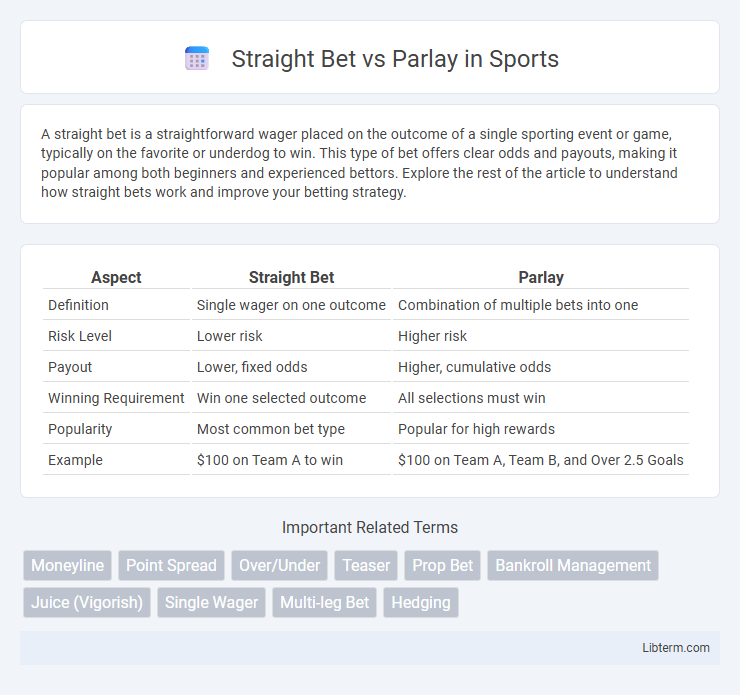A straight bet is a straightforward wager placed on the outcome of a single sporting event or game, typically on the favorite or underdog to win. This type of bet offers clear odds and payouts, making it popular among both beginners and experienced bettors. Explore the rest of the article to understand how straight bets work and improve your betting strategy.
Table of Comparison
| Aspect | Straight Bet | Parlay |
|---|---|---|
| Definition | Single wager on one outcome | Combination of multiple bets into one |
| Risk Level | Lower risk | Higher risk |
| Payout | Lower, fixed odds | Higher, cumulative odds |
| Winning Requirement | Win one selected outcome | All selections must win |
| Popularity | Most common bet type | Popular for high rewards |
| Example | $100 on Team A to win | $100 on Team A, Team B, and Over 2.5 Goals |
Introduction to Straight Bets and Parlays
Straight bets involve wagering on a single event or outcome, offering a straightforward way to win based on a specific prediction like a team's victory or total points scored. Parlays combine multiple bets into one, requiring all selections to win for the bettor to receive a payout, which increases potential rewards but also risk. Understanding the differences between straight bets and parlays is crucial for managing risk and optimizing betting strategies in sports wagering.
Defining a Straight Bet
A straight bet involves wagering on a single event or outcome with fixed odds, making it straightforward and easy to understand. The bettor must correctly predict the result, such as the winner of a game or whether the total points scored will be over or under a set line. This type of bet contrasts with parlays, where multiple bets are combined to increase potential payouts but require all selections to win.
Understanding Parlay Bets
Parlay bets combine multiple individual wagers into one bet, requiring all selections to win for a payout, which increases the potential return but also the risk. Unlike straight bets that involve a single outcome, parlays multiply the odds of each selection, offering higher rewards with lower initial stakes. Understanding parlay bets involves recognizing the balance between higher payouts and the increased probability of losing due to the need for multiple correct predictions.
Key Differences Between Straight Bets and Parlays
Straight bets involve wagering on a single event outcome with fixed odds, offering a higher probability of winning but lower potential payouts. Parlays combine multiple straight bets into one wager, requiring all selections to win, which increases the risk but significantly amplifies the potential payout. The key difference lies in the risk-reward balance: straight bets provide steady returns with lower stakes, while parlays attract bettors seeking larger profits through compounded odds.
Risk and Reward: Straight Bet vs Parlay
A straight bet involves wagering on a single outcome with a lower risk and a fixed payout based on standard odds, providing consistent but modest rewards. Parlay bets combine multiple individual bets into one wager, dramatically increasing potential payouts due to compounded odds but significantly raising the risk since all selections must win. The higher reward potential in parlays comes with a much greater likelihood of loss compared to the steady, lower-risk nature of straight bets.
Payout Structures Explained
Straight bets offer a fixed payout based on the odds for a single wager, making the potential return straightforward and easy to calculate. Parlay bets combine multiple selections into one wager, where all picks must win to earn a significantly higher payout, reflecting increased risk and reward. The payout structure for parlays multiplies the odds of each individual bet, resulting in exponential potential earnings compared to the single, linear payout of straight bets.
When to Choose a Straight Bet
Choose a straight bet when seeking a lower-risk wager with a higher probability of winning, as it involves betting on a single outcome with fixed odds. Straight bets are ideal for bettors who prefer consistent returns and want to avoid the complexity and cumulative risk associated with parlays. This type of bet is best suited for clear favorites or situations where detailed analysis supports a confident prediction.
Ideal Scenarios for Parlay Betting
Parlay betting is ideal for bettors looking to maximize potential returns by combining multiple wagers into a single bet, especially when confident in the outcomes of several games or events. This approach suits those willing to accept higher risk in exchange for significantly larger payouts compared to straight bets. Parlay bets work best when the individual legs have favorable odds, and the bettor has researched each selection thoroughly to increase the chance of hitting all outcomes.
Common Mistakes Bettors Make
Many bettors confuse a straight bet with a parlay, often underestimating the risk involved in parlays due to their higher potential payouts. Common mistakes include betting parlays without understanding how combining multiple outcomes increases the likelihood of losing the entire wager. Another frequent error is neglecting to manage bankroll effectively, as parlays can lead to significant losses faster than straight bets.
Which is Better: Straight Bet or Parlay?
Straight bets offer higher probability of winning by wagering on a single outcome with fixed odds, making them ideal for consistent, lower-risk returns. Parlay bets combine multiple selections into one wager, increasing potential payout but significantly lowering the chances of winning due to all picks needing to be correct. For bettors seeking steady profits and reduced risk, straight bets are generally better, whereas parlays suit those willing to accept higher risk for larger rewards.
Straight Bet Infographic

 libterm.com
libterm.com